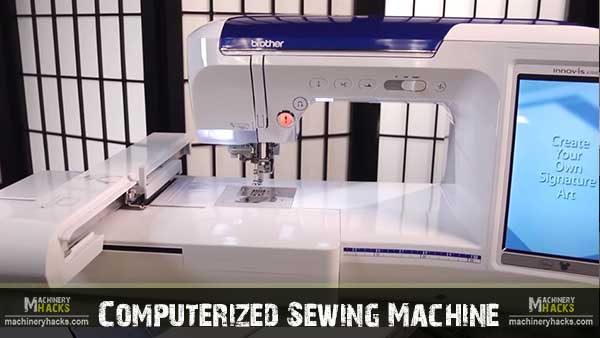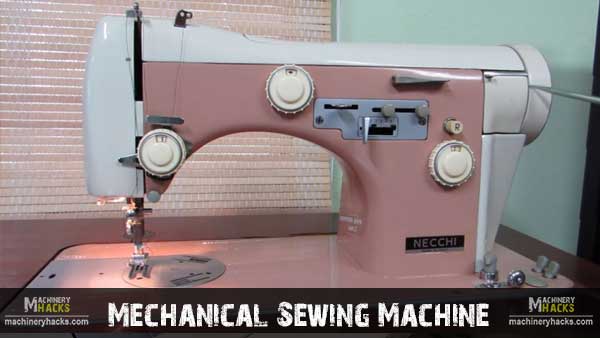Today, we’re going to try and get to the bottom of the mechanical vs computerized sewing machines issue. We’ll list some pros and cons of each and try to guide you toward making the right decision for you.
Since computerized sewing machines hit the market, there has been a debate to figure out which is best. Some see the computerized version as over complicating that which should be simple. Others are attracted by the extra versatility, and the extra stitching the computerized version can accomplish.
After all, it is you who will have to use the machine you purchase and not us! So, without further ado, let’s talk about sewing machines!
What exactly is a computerized sewing machine?

Well, the title of this machine explains its function perfectly. But there are also some additional bits of information that you need to know before choosing one. Computerized sewing machines are by nature much smoother to operate, which is why many insist on using them.
You also end up with a broader range of features, such as LCD displays, a range of built-in stitch patterns, and an automatic thread cutter. Depending on how much you are willing to spend, these features can become more extensive. Perhaps the most difficult change to adapt to when switching to computerized is that many models aren’t foot operated.
The advantages of buying a computerized sewing machine
Quick and easy buttonholes:
Making buttonholes is far easier on this type of machine, and with far more variety in designs. All the user has to do is to attach the buttonhole foot and press the button or hit the pedal. Because of this simplicity and range, we recommend using one of these machines if you intend to make a lot of clothing.
Way more stitch options:
The top of the range models of these machines can have literally hundreds of stitches. Even the cheaper models tend to have quite a few compared to a mechanical version. This is great if you make use out of them, but there is also a pitfall to be avoided.
Some get blinded by the sheer number of features and end up paying more for something that they essentially never use. It is best to assess your needs before making a purchase.
A heightened sense of control:
With one of these machines, the user can control the speed of the needle better. Some also report that they feel like they are more in control without having to use a foot pedal. Note: not all models come with in-body controls. Some are still foot operated.
Tons of automatic features:
These machines come packed with features designed to make your work easier. Our personal favorite is the automatically deployed locking stitch. This can be selected to finish the stitching underneath for a nice tidy and strong finish. Other features may include:
- Automatic threading
- Automatic up and down
- Automatic tension setting
- Automatic thread-cutting
The disadvantages of buying a computerized sewing machine
One observation that several people make when comparing the two types of sewing machines is that the computerized ones aren’t going to last as long. Yes, it is true that you can still see a lot of old ‘Singer’ models that are still in use decades after they were made. Computerized models, however, may become obsolete after a few years.
It is not necessarily that you will need to replace your machine; you may simply be attracted by new and exciting features on a more modern machine. Technology evolves quickly, ever making our lives easier – why not update your machine as the technology evolves?
On a more disheartening note, it can be the case that some of the older machines just have a more robust build quality, enhancing longevity.
Other cons include:
They can be pretty pricey:
Though it is the case that entry levels can be reasonably affordable, as the list of features grows, so does the price tag. For some of us, this can mean that we are effectively priced out of making the decision to buy one.
Do you really need all those features?
Some of the more complicated computerized units have an absurd range of features. These are features which even some professionals will never actually used. So, for a beginner, many will find that a base level model or a mechanical model will suit their needs adequately.
How does a mechanical sewing machine work?

For starters, operating a mechanical sewing machine is much simpler for beginners. There are no buttons to press, you choose your stitching patterns by turning a dial etc. As a result, these machines are cheaper than their computerized friends. That being said: don’t be fooled by their cheapness.
Many artisans still prefer to use this type of machine as they say it enables them to feel “close” to their craft. Sure, there are less options for stitching patterns, and a lot more to do manually (adjusting the needle etc.), but they are still a good option for many.
The advantages of buying a mechanical sewing machine.
Many people end up choosing a mechanical sewing machine simply because they are cheaper. This is of course true in nearly every case, but there also some other pros that are worth considering; for example:
The easy maintenance:
Mechanical machines are a lot more basic in design, whereas with computerized ones there is a lot more that can go wrong. When they do, the mechanical is much easier to handle by yourself. Basically, less intricacies lead to less problems in the long run.
They can be REALLY heavy-duty!
The more upmarket of these machines can feel almost indestructible. We’ve seen vintage and modern examples of these that can manage to stitch through even the toughest of materials.
They’re cheaper:
Yes, we’re aware that we’ve stated this already, but it’s worth mentioning again. Plus, there is no need to spend money on extra features that you may never end up using.
The disadvantages of buying a mechanical sewing machine:
Can actually be more complicated to use at times:
Whereas computerized machines tend to do a lot of the work for the user, beginners may struggle with playing with settings for the first while. All of this can be overcome with a little practice, however.
Less stitching options:
Some of the new computerized machines have literally hundreds of stitches. That is not the case with their mechanical counterparts. So, if you’re the type of person who would avail of having hundreds of stitches, this type of machine isn’t for you. However, the majority of users tend to only actively use a few settings.
We’d recommend giving some thought to this before committing to a purchase.
Fewer options for buttonholes:
If you are intending to make clothes with your new machine, the mechanical machine suffers from a lack of options for buttonholes. It may be better to look elsewhere if this is your intention.
Frequently Asked Questions (FAQs):
Many manufacturers state that their machines can last upwards of 25 years if treated correctly. This means that in exceptional situations, when the machine is serviced once a year as is recommended, there should be no reason to replace yours any time soon! However, many people choose to invest in a new one after a few years as machine with new features are released.
It depends. If you need a machine with hundreds of stitches and an extra degree of automation, then it is definitely better to invest in a computerized machine. However, if you are not going to actually use these features, it is much cheaper and just as effective to operate a mechanical sewing machine.
Whereas many computerized models come with a foot pedal, these same models can still be operated at the push of a button. This option can be very useful for those who are making the changeover from mechanical to computerized.
For those who intend to use a broad variety of stitches and need a selection of buttonholes, a computerized sewing machine is their ideal companion. As such, we recommend buying one if your niche is designing intricate pieces of clothing.
So, which should I choose?
At the end of the day, the best choice is always the one you make after getting all the information. Because of this, we can’t exactly say which is best. It depends on factors such as:
- Your budget.
- What you want to use it for.
- Your own personal preferences.
The best advice we can give is to consider Mechanical or Computerized Sewing Machine you’re looking at under these criteria. After that, all that is left to do is to pick the machine that fits your style and buy the best version of it you can afford. We hope that this has helped to clear up some of the mystery for you and that you move forward making the best decision possible for you.
You can also read:
Top 5 Best Mechanical Sewing Machine